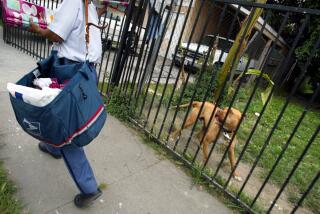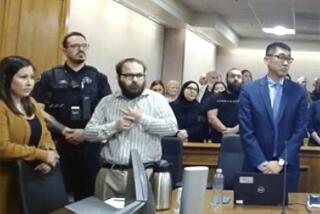Mass Killer Had Been Put on Leave by Postal Center
- Share via
GOLETA, Calif. — The former postal worker who fatally shot five employees and wounded another at a mail distribution facility in Goleta had been placed on medical leave three years ago for psychological problems, authorities said Tuesday.
“She had not threatened anyone, but other employees were concerned for her welfare,” said Randy DeGasperin, an inspector for the U.S. Postal Service, explaining why sheriff’s deputies removed Jennifer Sanmarco from the building three years ago.
Sanmarco -- perhaps the first woman responsible for shootings at a postal facility, officials said -- had worked at the massive sorting center for six years before she was forced to take a leave, DeGasperin said at a news conference. Sanmarco has not worked for the Postal Service for some time, though when or why her employment ended is unclear.
The last known address for Sanmarco, 44, was Grants, N.M. Why she returned to the facility Monday night with a shaved head, a semiautomatic 9-millimeter pistol and deadly intent is still under investigation.
A resident at Sanmarco’s former condominium complex on Overpass Road, where Sanmarco lived from 1998 to 2003, described her as difficult and inflexible when dealing with others. Sanmarco, who worked a night shift, pounded on the wall when neighbors took morning showers because the noise disturbed her.
“She was always talking to herself, but she didn’t make any sense,” said the woman, who asked not to be identified. “Her sentences weren’t structured. I didn’t understand anything she said.”
The neighbor went out of her way to avoid Sanmarco.
“She’d be walking in my direction and I’d cross the street,” she said.
Sanmarco’s rampage Monday took only minutes. She shot two employees while in the parking lot, one by the front door and three more inside before turning the gun on herself, authorities said.
Whether she fired at random or carefully selected her victims is unknown.
The Santa Barbara County Sheriff’s Department, the FBI, postal inspectors and personnel from other agencies were scouring the 200,000-square-foot building for clues and interviewing the dozens of shaken witnesses who had been shepherded Monday night by police to the safety of a fire station across the street.
The dead were identified by postal officials as: Ze Fairchild, 37, of Santa Barbara; Dexter Shannon, 57, of Oxnard; Nicola Grant, 42, of Lompoc; Guadalupe Swartz, 42, of Lompoc; and Maleka Higgins, 28, of Santa Barbara.
The wounded employee was taken to Santa Barbara Cottage Hospital and identified as Charlotte Colton, 44, of Santa Barbara.
Goleta Mayor Jonny Wallis called the shootings -- the first such fatalities at a postal facility in eight years -- “a shock to the soul.”
Goleta, a city of about 30,000 just west of Santa Barbara, is a haven for UC Santa Barbara professors, surfers, high-tech workers and suburbanites.
As officials Tuesday tried to reconstruct Monday night’s events, a grim picture of blood and terror took shape.
Sanmarco turned off busy Storke Road and motored up the long driveway to the employee parking lot at the facility about 9 p.m. She apparently followed a worker’s vehicle so closely that she did not need the key card usually required to enter the lot, which is surrounded by a chain-link fence topped with barbed wire.
The employee door requires another key card. Whose card she used for entry is under investigation.
Once inside, she immediately shot Colton, and then proceeded to an area where she killed the other two employees and herself, Santa Barbara County Sheriff Jim Anderson said.
A witness saw her reload, he said.
Within minutes, Santa Barbara County sheriff’s deputies had arrived, formed a “crisis entry” squad and called in SWAT teams from both the county and the city of Santa Barbara.
Not knowing whether the assailant was awaiting them somewhere within the maze of bins, counters and corridors, the teams advanced slowly and discovered the three bodies inside the building about 2 a.m. -- five hours after the first emergency call.
About 80 people were working the night shift.
One hid in the facility for more than three hours. He finally used his cell phone to call 911 and lead deputies to his makeshift shelter, said Erik Raney, a Sheriff’s Department spokesman. He was escorted to the fire station about 12:30 a.m.
Though there have been heavily publicized instances of violence at postal facilities, no problems had been reported at the Santa Barbara Processing and Distribution Center in Goleta.
There were no security guards or metal detectors. DeGasperin said a “full security review” will be conducted.
“No system is foolproof,” he said.
Don Smeraldi, a Postal Service spokesman, bristled at descriptions of the former employee “going postal.”
The service’s 700,000 employees hear the phrase and think of mail carriers saving the lives of people on their routes, helping elderly customers who have fallen down and doing their jobs despite hurricanes, he said.
“To us, that’s what the term means,” he said.
In light of the shootings at 10 post offices from 1986 to 1998, the United States Postal Service commissioned a report that concluded that the post office was still a pretty safe place to work.
“ ‘Going postal’ is a myth, a bad rap,” said the report, which was released in 2000. “Postal workers are no more likely to physically assault, sexually harass or verbally abuse their co-workers than employees in the national workforce.”
The murder-suicide was unusual in that the murders were committed by a woman, unlike the other 90.4% of such tragedies, according to the Violence Policy Center in Washington, D.C.
“To have a mass murder by a woman must be incredibly rare,” said Richard V. Denenberg, author of “The Violence-Prone Workplace.”
The use of a gun in such a case is also rare.
If anything, Denenberg said, women are more likely to victimize others through indirect means, such as arson.
Raymond O’Hara, an expert on workplace violence, hopes that the Goleta shootings won’t prompt paranoia about disgruntled female co-workers.
“There will be a million Monday night quarterbacks on this, but the reality is that this was one lady doing this in this one instance,” said O’Hara, the senior managing director of Vance, a security consulting firm.
The better lesson learned, O’Hara said, is to keep the lines of communication open before bottled-up resentment bursts into brutal backlashes.
Times staff writer Tanya Caldwell in Los Angeles contributed to this report.
More to Read
Sign up for Essential California
The most important California stories and recommendations in your inbox every morning.
You may occasionally receive promotional content from the Los Angeles Times.














